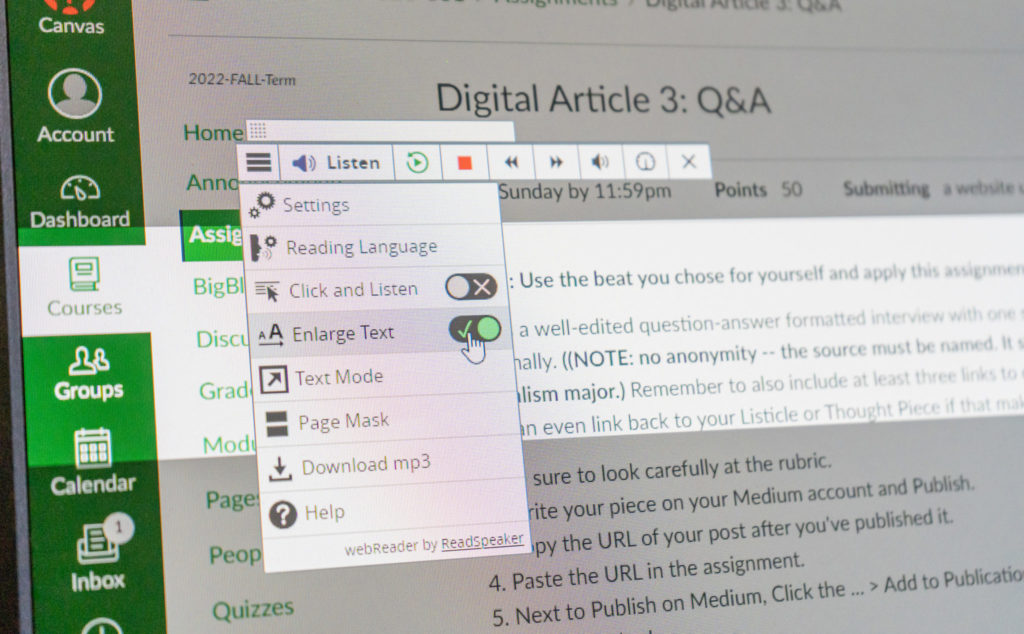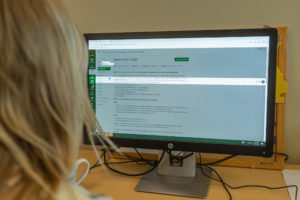
Last fall, Colorado State University continued its commitment to creating an accessible and inclusive campus by adding a new campuswide tool. The beginning of the 2022-23 academic year at CSU saw the introduction of ReadSpeaker to Canvas, CSU’s web-based learning management system that supports online learning and teaching.
This year, the University Technology Fee Advisory Board (UTFAB) provided funding for another year of ReadSpeaker. UTFAB is a student-run organization that oversees and approves the use of student technology fees for improvements across the university.
ReadSpeaker is a free, user-friendly assistive technology software that encompasses three different tools: TextAid, webReader, and docReader, which make PDFs, Canvas, and web pages more accessible. All students can use and potentially benefit from using ReadSpeaker.
Specifically, this technology is a text-to-speech tool that reads content aloud: directly from the web page, or within electronic files such as PDFs. Files can also be converted to MP3 for download and offline listening. While the text is being read aloud, it can also highlight words and sentences to follow along with the audio and users have the ability to change reading speed, voice, and language for a fully customizable experience. Visually, users can make adjustments such as setting different font styles, changing font and background color and using the annotation feature to highlight and sort highlighted information by color. Perhaps one of the most popular features of ReadSpeaker is its mobile browser compatibility, allowing for listening on the go.
ReadSpeaker as inclusive design
Marla Roll, director of the Assistive Technology Resource Center at CSU, and ATRC staff worked closely with ReadSpeaker and the university to ensure every student has access to these tools.
Traditionally, tools such as ReadSpeaker are provided to students as part of a disability accommodation. However, a 2022 study from the National Center for Educational Statistics showed only about a third of college students with disabilities sought accommodations. More surprisingly, data from a recent Educause survey found that nearly 1 in 4 undergraduate students benefits from text-to-speech tools.
ATRC staff aren’t surprised by that discrepancy. “We know there’s a large gap between the students who benefit from this kind of support and those who actually receive it,” said Chelsea Hansen, ATRC administrative assistant. “Providing ReadSpeaker to the entire campus is great inclusive design – we’re proactively meeting students’ needs rather than requiring them to go through the accommodations process first.”
One of the main goals surrounding ReadSpeaker is to make the use of assistive technology tools a norm for the entire university population.
“It’s added to the tools that CSU provides to make your learning opportunities richer,” said Roll.
Lynsey Fenter, accommodation specialist in the Student Disability Center, recommends these tools to all students, citing time management as a prominent reason.
“Students’ lives are busy as they navigate class, pages on pages of reading, outside jobs, commuting, and the general chores associated with being a human. These tools provide a way for students to engage with the material needed for class, while also keeping up with the other aspects of their life key to their success and wellbeing,” Fenter explained. “Having these tools readily available in Canvas will be a game changer for students. I believe we will see all students utilizing these tools for a multitude of reasons.”

The importance of ReadSpeaker to all students is clear, but there are also added benefits for faculty.
Fenter described TextAid as “opening a world of possibility for material utilized in a course.” She added, “With TextAid, faculty and students can engage with web-based material using text-to-speech, already embedded into Canvas.”
Instructors can inform students about ReadSpeaker by including information in their syllabi. For a sample blurb to add to your syllabus, visit the ReadSpeaker for Canvas information page.
To make ReadSpeaker the most effective for students, instructors are encouraged to ensure their documents are accessible, especially PDFs. Without accessible documents, students will not be able to use the tool. For more information on making PDFs accessible in Canvas, see UDOIT for Canvas.
ReadSpeaker and the opportunities it provides to students reinforce the ambition of CSU to create an accessible and beneficial educational environment for all students, faculty, and staff.
Accessing and using ReadSpeaker
The ReadSpeaker suite contains three different products: webReader, TextAid, and docReader.
WebReader reads content within a Canvas page. DocReader reads documents uploaded into Canvas, and TextAid allows a student to upload and listen to any document from their computer into their own personal library. Additionally, there is a TextAid web extension available for download, which can read any other website aloud. The ReadSpeaker suite is available for free to all students, faculty, and staff within Canvas and can be accessed from any web page within Canvas. Conveniently, the assistive technology tool does not require a download apart from the optional web extension.
ReadSpeaker has a plethora of resources designed to make the use of these tools as easy as possible. The instructional videos included below are a great way to get started, but if you are looking for more information you can visit the ATRC ReadSpeaker website and also connect with specialists on campus.
webReader
TextAid
TextAid Extension
docReader
The bottom line
The ReadSpeaker suite is still in a pilot phase at CSU as the University attempts to strengthen its commitment to creating and sustaining a welcoming, accessible, and inclusive campus that enhances usability for everyone and helps create an environment in which we support, protect, and respect rich dimensions of diversity.
During this time, the ATRC is collecting feedback on your experience with the ReadSpeaker tools. This feedback will help determine whether to renew the software going forward. To submit feedback fill out this anonymous survey.
ReadSpeaker was made possible this year through the collaboration of the University Technology Fee Advisory Board, Assistive Technology Resource Center, and support from the University’s IT department.
Marla Roll summed it up by saying, “ReadSpeaker and the ability to offer ease of access tools to students is part of meeting our commitment to CSU’s Principles of Community.”
Ethan Dvorak contributed to this story.
The Assistive Technology Resource Center is in the Department of Occupational Therapy, part of CSU’s College of Health and Human Sciences.